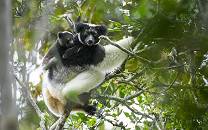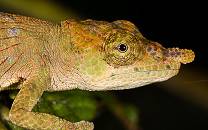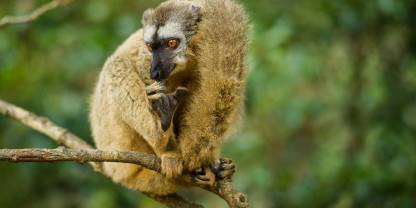Mitsinjo Forest (Parc Mitsinjo) borders Analamazaotra National Park, which is part of Andasibe-Mantadia National Park. It is run as a community project by a local guides association. The forest patch is undergoing rehabilitation through the planting of indigenous trees. As in the national park, the main activity here is tracking the indri. Night walks are a big draw as they are not permitted inside Analamazaotra, and other activities are also possible.

-
Best Time To Go
- April, May, October and November (Mild weather, less rain)
-
High Season
- July, August and December holidays (The forest gets busy)
-
Size
- 7km² / 3mi²
-
Altitude
-
900m /2,953ft
 View Photos
View Photos
 View Photos
+24
Photos
View Photos
+24
Photos
Pros & Cons
- Easily accessible from Andasibe-Mantadia National Park
- Less busy than the national park
- Offers a chance to support a local NGO (non-governmental organization)
- Home to the indri, Madagascar’s largest lemur
- Night walks inside the forest available
- Good accommodations options around nearby Andasibe village
- High-altitude rainforest is often cold and wet
- Patches of deforestation interrupt the wilderness feel
Wildlife
This relatively small forest is home to, at last count, seven indri families. Sightings are pretty much guaranteed and indri feeding may also be possible. Common brown lemur and eastern woolly lemur are often spotted as well. Wildlife to look out for during night walks include the nocturnal Goodman’s mouse lemur, chameleons such as Parson’s and stump-tailed chameleon, leaf-tailed geckos and a variety of frogs.
More about Mitsinjo’s wildlifeScenery
Mitsinjo Forest is made up of mid-altitude rainforest. Many of the big trees have been logged and what’s left is mainly secondary forest with a lot of undergrowth. However, recent plantings of native forest species are a real sign of hope and, unless you’re a botanist, you’ll likely think the forest looks pretty impressive. Visitors can contribute financially.
Activities
Mitsinjo has four hiking circuits, some quite steep, which take from one to five hours to complete. A guided walk is the main way to see the park’s wildlife, and night walks through the forest are a highlight here. You can also take a village tour of Andasibe, explore the on-site frog terrarium, feed the indris, and do your bit for conservation by planting a tree.
Weather & Climate
Due to the altitude of the rainforest, Mitsinjo has a cool, wet climate. It rains throughout the year, but the Wet season (November to April) has very high rainfall. The rains peak from December to March, with January to March often referred to as the cyclone season. During the warm Wet season, temperatures average 28°C/82°F. The cooler Dry season (May to October) has average daytime temperatures of around 24°C/75°F.
More about the weather and climateBest Time To Visit
Mitsinjo Forest can be visited throughout the year. However, the shoulder months of April, May, October and November are ideal as the weather is mild and there isn’t too much rain. In October and November many lemurs have babies. The wettest months from January to March are best avoided. Some animals, especially reptiles and amphibians, are less easy to spot in the cold drier months from June to September.
More about the best time to visit
